Two years after its historic deep freeze, Texas is increasingly vulnerable to cold snaps – and there
Texas wasn’t prepared to keep the lights on during Winter Storm Uri, and it won’t be ready for future cold weather unless it starts thinking about energy demand as well as supply.

Texans like to think of their state as the energy capital of the world. But in mid-February 2021, the energy state ran short of energy.
An intense winter weather outbreak, informally dubbed Winter Storm Uri by the Weather Channel, swept across the U.S., bringing snow, sleet, freezing rain and frigid temperatures. Texas was hit especially hard, with all 254 counties under a winter storm warning at the same time.
Across the state, sustained arctic temperatures froze power plants and fuel supplies, while energy demand for home heating climbed to all-time highs. Cascading failures in the electric power and natural gas sectors left millions of people in the dark for days. At least 246 people died, possibly many more, and economic damage estimates damages reached US$130 billion.
Water systems, which require energy for pumping and treatment, also were severely damaged. At least 10 million people were under boil-water notices during and after the storm, sometimes for weeks. Low-income and minority residents, who had fewer resources to find alternative housing and make repairs, suffered the worst impacts.
As energy researchers based in Texas, we have spent much of the past two years analyzing why the state was so unprepared for this event and how it can do better. A common knee-jerk reaction to disasters that cause widespread power outages is to call for building more “firm” power plants – those that use fuels like coal or natural gas and are designed to deliver power at any time of day or night. But coal and gas plants, and their fuel supplies, can fail spectacularly.
We think it is important to think beyond just building more power plants. Our findings spotlight other solutions that can be cleaner, cheaper and faster to put in place.
Planning for winter
Analyses after Uri revealed that a lack of winterization in the electric and gas sectors was a critical cause of systemwide failure. The Texas legislature enacted new winterization requirements for electricity generators. But it did not do the same for natural gas producers, which provide fuel to about 40% of Texas power plants and weren’t able to deliver during the storm.
Since then, Texas saw significant drops in natural gas production during winter cold snaps in January and February 2022. As happened during Uri, production at many gas wells was halted because water and other liquids that come to the surface with the natural gas froze when they hit a frozen wellhead, creating an ice dam and stopping the flow of gas into pipelines.
In December 2022, Winter Storm Elliott caused more drops in gas production, as well as power outages across the Southeast U.S. These events show that winter reliability risks are not specific to Texas.
Cold weather challenges
Our research shows that winter peak electricity demand in Texas – driven by electric space heating – has become more sensitive to cold temperatures over the past 20 years. Winter peaks are also growing faster and are more erratic than summer peaks. We know that every summer is going to be hot, but we don’t know for certain that winter will be cold, which makes it harder to plan.
Texas is at the forefront of a national shift to heating homes with electricity instead of oil or gas. About 60% of homes in Texas use either heat pumps or electric resistance heating.
Heat pumps shift home winter energy demand from carbon-emitting sources like natural gas to electricity. They can also cool buildings more efficiently than older air conditioning units. However, heat pumps that aren’t rated for low temperatures can use more energy to heat in the winter than to cool in the summer. Better minimum efficiency standards can help mitigate this challenge.
The shift to electricity for heating indicates that within the next few decades, electricity demand in Texas is likely to regularly peak in winter rather than summer. Meanwhile, lower-demand shoulder seasons in spring and fall – the times when fossil fuel and nuclear power plants normally go offline for maintenance – are getting shorter, as heat waves start earlier and winter storms push later into the spring.
What do we do now?
These trends are making it harder for grid planners and operators to ensure sufficient power capacity is always available, especially in winter. In addition to making sure Texas has enough generating capacity online, here are three areas where we believe the state should do more:
– Promote energy efficiency.
Currently the nonprofit American Council for an Energy-Efficient Economy ranks Texas 29th among the states for its policies and programs to save energy and promote energy efficiency. Adopting policies such as stricter building codes and minimum appliance efficiency standards would reduce consumers’ energy bills. It also would lower peak demand during extreme events. And if outages still occur, well-insulated houses will stay warm or cool for longer, reducing risks to occupants.
– Increase investment in demand response.
Demand response programs offer electricity customers incentives to turn off noncritical appliances, like pool pumps or water heaters, for short periods to reduce overall load on the grid during periods of high demand. For real-time balancing of supply and demand on the grid, turning off 500 megawatts of noncritical demand is functionally equivalent to turning on a 500-megawatt power plant. While Texas has made some progress in this area, it is below average relative to its peers.
Our research shows that Texas could free up 7 gigawatts or more of electric generating capacity through demand response, which would double what it has available today.
Increasing demand response can be cheaper than building new power plants. While a new wind or solar farm might cost $1,000 or more per kilowatt of generating capacity, demand response programs cost about $200 per kilowatt of demand that can be turned off.
It’s also faster. Technicians can install thousands of remote-controllable thermostats or appliance switches in months, compared with the years of lead time required to site, license and build new power plants.
– Connect Texas’ isolated power grid to the Western and Eastern interconnections.
Most electricity in the U.S. is generated and sold over two large grids that cover nearly all of the lower 48 states. Texas has kept its own grid inside state lines as a way to minimize federal regulation of its power sector. While there are some very weak direct-current ties to those grids, Texas utilities can’t import meaningful amounts of power when supplies are scarce, or export it when they have a surplus and neighboring states need support.

Expanded grid connectivity would make electricity supply in Texas more reliable and enable generators to export low-carbon power from the state’s abundant wind and solar farms. Rapid growth in wind and solar generation in Texas has saved the state’s consumers billions of dollars while making a lot of money for rural landowners and local governments.
Those economically beneficial renewable power plants will eventually saturate the limited Texas market. Opening access to consumers in other states by connecting Texas to other grids would continue to spur economic growth and job creation in rural areas and would give the state grid a lifeline during extreme events. Our ongoing research shows that this would be a cheaper and cleaner way to assure reliability than just adding more natural gas power plants.
Texas officials often tout the state’s “all of the above” energy strategy, but that vision focuses heavily on production. In our view, an approach that employs every tool in the toolbox – including efficiency, demand response and increased grid connectivity – would better serve the state.
Michael E. Webber receives funding from variety of government agencies, foundations, and industry, including financial institutions and energy companies. A full list of supporters is available at http://www.webberenergygroup.com. He is on the board of GTI Energy, CTO at Energy Impact Partners, and co-founder and Chairman of IdeaSmiths LLC, an engineering consulting firm. Any opinions, findings, conclusions or recommendations expressed in this material are those of the authors and do not necessarily reflect the views of the sponsors, Energy Impact Partners, GTI Energy, or IdeaSmiths LLC. The terms of this arrangement have been reviewed and approved by the University of Texas at Austin in accordance with its policy on objectivity in research.
Drew Kassel receives funding from META Technologies, Artesion, Grid United (GU), and the State Energy Conservation Office (SECO). Any opinions, findings, and conclusions or recommendations expressed in this material are those of the author(s) and do not necessarily reflect the views of the sponsors or the University of Texas at Austin.
Joshua D. Rhodes receives funding from variety of government agencies, foundations, and industry, including financial institutions and energy companies. A full list of academic supporters is available at http://www.webberenergygroup.com and list of public consulting reports, including those that funded them, is available at https://www.ideasmiths.net/reports-publications/. He is on the board of Catalyst Cooperative, and co-founder and CTO of IdeaSmiths LLC, an engineering consulting firm. Any opinions, findings, conclusions or recommendations expressed in this material are those of the authors and do not necessarily reflect the views of the sponsors, clients, the University of Texas, Columbia University, or IdeaSmiths LLC. The terms of this arrangement have been reviewed and approved by the University of Texas at Austin in accordance with its policy on objectivity in research.
Matthew Skiles receives funding from the University of Texas at Austin and from the National Science Foundation Graduate Research Fellowship Program under Grant No. DGE-1610403. Any opinions, findings, and conclusions or recommendations expressed in this material are those of the author(s) and do not necessarily reflect the views of the University of Texas at Austin or the National Science Foundation.
Read These Next
Who thinks Republicans will suffer in the 2026 midterms? Republican members of Congress
The president’s party almost always loses seats in the midterms. More than two dozen Republican House…
New materials, old physics – the science behind how your winter jacket keeps you warm
Winter jackets may seem simple, but sophisticated engineering allows them to keep body heat locked in,…
Deepfakes leveled up in 2025 – here’s what’s coming next
After a year of fast advances, deepfakes are entering a new era defined by real-time interaction with…






